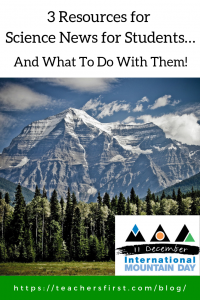 December 11 is International Mountain Day. The purpose of this occasion is to highlight the importance of mountains as a resource for over half of the world’s population and also recognize the damaging effects of climate change, overpopulation, and over-exploitation of resources. Although this isn’t a famous event, the purpose and issues are ones that generate concern around the world. Also, it is critical that our students have the opportunity to understand and learn about these types of climate concerns through grade-appropriate non-fiction resources.
December 11 is International Mountain Day. The purpose of this occasion is to highlight the importance of mountains as a resource for over half of the world’s population and also recognize the damaging effects of climate change, overpopulation, and over-exploitation of resources. Although this isn’t a famous event, the purpose and issues are ones that generate concern around the world. Also, it is critical that our students have the opportunity to understand and learn about these types of climate concerns through grade-appropriate non-fiction resources.
There are many science resources available to choose from for all grade levels. For ongoing daily exposure to science content, I’d suggest using science news magazines as an excellent way to motivate and encourage students to learn more about the science in their daily lives.
These are some of my favorites digital magazines for science news for kids of all ages.
- Science News for Students (TeachersFirst review) – this digital magazine is an excellent resource for students in grades 6 and older. Many of the articles address different aspects of climate change; find all of them by choosing the Topics link and selecting Earth and Environment. Each piece contains a list of “Power Words.” This is a glossary of words found that might need clarification for younger readers.
- Bookmark this site on classroom computers for student use. Articles are updated often, so students will continue enjoying the newest information from the site.
- Use the search tool to find specific content for your current teaching units and use as lesson activators.
- After reading and discussing information from this site, have students write and produce science podcasts sharing the latest science news from around the world. If you are new to podcasting or need some tips, this OK2Ask session archive shares ideas to get you started and information about free podcasting tools.
- National Geographic Kids (TeachersFirst review) – this site is very popular, and for a good reason. The information is engaging and understandable to students from kindergarten on up. In addition to short articles, students will also enjoy the games and videos available. Use the search bar to find content for your specific needs. For example, I searched for mountains and found a variety of resources including mountain animals, habitats, and profiles of different countries with mountains.
- For younger students, share articles and videos on your interactive whiteboard to discuss together.
- Use this Venn Diagram creator (TeachersFirst review) to compare and contrast fiction vs. non-fiction.
- Use this cube creator from Read, Write, Think (TeachersFirst review) and ask students to summarize and share information from the articles. Consider using one side of the cube to include questions for further exploration.
- ScienceTake (TeachersFirst review) – is a video science magazine from the New York Times mainly focusing on animals. The short videos use amazing video footage to demonstrate the science behind unusual topics such as How to Give a Spider an Eye Test!
- Use videos from the site as inspiration for science fair projects, or a science open house at your school.
- After watching videos, have students create a science explainer video. Use Biteable (TeachersFirst review) to develop professional-looking explainer videos using your images and text.
- Create a complete unit including links to videos from this site using Symbaloo Learning Paths (TeachersFirst review) for students to complete on their own. Symbaloo Learning Paths includes tools for adding videos, quizzes, uploading documents, and more. Creating different paths offers the opportunity to differentiate learning activities and allow student choice. Learn more about this by viewing our archive of this OK2Ask session devoted to Symbaloo Learning Paths.
Take a more in-depth look at these science magazines and consider using them across the curriculum:
- Social Studies – use information from the articles as inspiration for learning about cultures around the world, find and locate countries and cities, or compare and contrast data to your students’ everyday lives.
- Math – science news lends itself easily to many math concepts. Use the information in the articles to create graphs, explore data, or build word problems using data found in the article.
- English/Language Arts – the first obvious use of these sites is to provide high-interest, high-quality non-fiction reading material to your students. Take it a step further and offer online magazines to your students as a model for student writing and to complement fiction reading material with non-fiction. For example, pair a fiction book like Maxwell’s Mountain with this article about the Great Smoky Mountains found on National Geographic Kids. TeachersFirst provides many suggestions in CurriConnects. This extensive collection of books related to curriculum topics, sorted by content and reading level, shares a variety of both fiction and non-fiction book suggestions.
- Art – these online magazines contain beautiful images. Share them with students to use as inspiration for different styles of artwork or to create sculptures.
- Music – learn about the music from cultures discussed in the science articles or have students compose music inspired by images found during their reading time. Check out this great YouTube channel (TeachersFirst review) from an inspirational science teacher with science concepts set to song.
Think about the science resources offered to students in your classroom. Are you making the most of them? How can you incorporate science better across the curriculum? We love hearing from our readers with their suggestions; share your ideas in the comments below.

